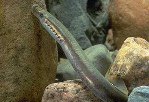| Family: |
Petromyzontidae (Northern lampreys), subfamily: Lampetrinae |
| Max. size: |
18 cm TL (male/unsexed); max. reported age: 8 years |
| Environment: |
demersal; freshwater; pH range: 6 - 7.3 |
| Distribution: |
North America: Atlantic Slope from Susquehanna River drainage in southeastern Pennsylvania to Neuse River drainage in North Carolina, USA; Mississippi River basin from Pennsylvania to Missouri and Arkansas south to Alabama, USA; Mobile Bay and Pascagoula River drainages in Georgia, Alabama and Mississippi, USA. |
| Diagnosis: |
Characterized by having oral disc narrower than head; teeth extremely degenerated; usually 52-59 trunk myomeres; coloration consisting of light tan to silver gray above, yellow or white below; and yellow or gray fins (Ref. 86798). Other adult diagnostic features: 7.5-17.8 cm TL and wet weight 0.9-3.0 g for individuals 8.2-12.0 cm TL. Body proportions, as percentage of TL (based on 166 specimens measuring 7.5-16.5 cm TL): prebranchial length, 6.9-13.0; branchial length, 8.4-12.8; trunk length, 42.8-57.3; tail length, 23.4-35.0; eye length, 0.9-2.1; disc length, 2.8-6.7. Urogenital papilla length, as a percentage of branchial length, in 71 spawning males measuring 10.2-14.6 cm TL, 23.1-60.0. Trunk myomeres, 53-62. Dentition: marginals, 63-67; supraoral lamina, 2 unicuspid teeth; infraoral lamina, 5-13 unicuspid teeth; 3-4 endolaterals on each side; endolateral formula, 2-1-2 with variations, including 1-1-1, 2-3-2 and 2-3-3; 2 rows of anterials; first row of anterials, 4-5 unicuspid teeth (some teeth may even be found on the anterior field between the supraoral lamina and the first row of anterials); 1-2 rows of exolaterals on each side; 0-1 row of posterials; first row of posterials, when present, may be complete (13% of individuals) or incomplete (87%) with 1-22 unicuspid teeth; transverse lingual lamina, undetermined number of unicuspid teeth, the median one of undetermined size; longitudinal lingual laminae each with an undetermined number of unicuspid teeth. Velar tentacles, 3-5, with tubercles. Body coloration (live) of spawning individuals, dorsal aspect mottled gray-brown and ventral aspect light silvery-yellow. Lateral line neuromast pigmentation unrecorded. Caudal fin pigmentation, darkly pigmented, but the extent of coverage has not been reported. Caudal fin shape, spade-like. Oral fimbriae number unrecorded. Oral papillae, 12-20 (Ref. 89241). |
| Biology: |
Freshwater, in streams and lakes (Ref. 89241). Inhabit clean, clear gravel riffles and runs of creeks and small rivers (Ref. 3814). In Delaware, occurs in small streams with relatively slow current, usually 0.03 m/s or less, with water temperatures throughout the year 4.0-19.0 °C, dissolved oxygen 5.6-14.0 ppm, and pH 6.0-7.3. In Kentucky, occurs in small to medium size, clear creeks with sand-gravel substrate, either among debris (adults) or in mud banks with silt deposits (ammocoetes) (Ref. 89241). Ammocoete larvae occur in spring-fed wetlands and quiet pools and backwaters of small, sandy or muddy bottom streams (Ref. 3814). Larval period varies from 2.5 to at least 5.4 yrs. Metamorphosis in early September and maybe even mid- to late August. In Maryland, metamorphosis has been reported as late as February (Ref. 89241). Adults enter riffle areas to spawn at 10-16°C water temperature (Ref. 10294). Non-parasitic (Ref. 3814). Fecundity, 572-3,816 eggs/female and relative fecundity, 373-687 eggs/g body weight. Egg diameter, 0.66-1.36 mm. In Delaware, spawning occurs at the end of March at a water temperature of 13.8 °C, dissolved oxygen 11.6 ppm, and pH 6.6. In Maryland, spawning occurs from 10 April to 10 May when the water reaches 16 °C. Both sexes participate in nest building. Stones up to 2.5 cm in diameter are moved using their oral disc. Nests are circular or oval, 15-2 cm in diameter and about 7 cm deep. They are built in streams 4.5-.3 m wide and 15-1 cm deep with a substrate of sand and fine gravel. From 2-5 lampreys share a nest. Up to two males will spawn with one female. Average size at hatching, 3.4 mm TL. Modal length at age 1 is 27-8 mm TL and at age 2 is 50 mm TL. Most growth occurs during the spring season, intermediate growth in summer and fall and very little during winter. In Kentucky, mean length at age 1 is 39 mm TL, at age 2 is 65 mm TL, and at age 3 is 89 mm TL (Ref. 89241). |
| IUCN Red List Status: |
Least Concern (LC); Date assessed: 21 February 2012 Ref. (130435)
|
| Threat to humans: |
harmless |
Source and more info: www.fishbase.org. For personal, classroom, and other internal use only. Not for publication.

